Up Next
‘The Sculpture Is a Physical Mirror for Me’: Artist Langdon Graves Constructs Visual Riddles
The artist's solo exhibition "Time is A Fire" is now on view at Dinner Gallery in New York.
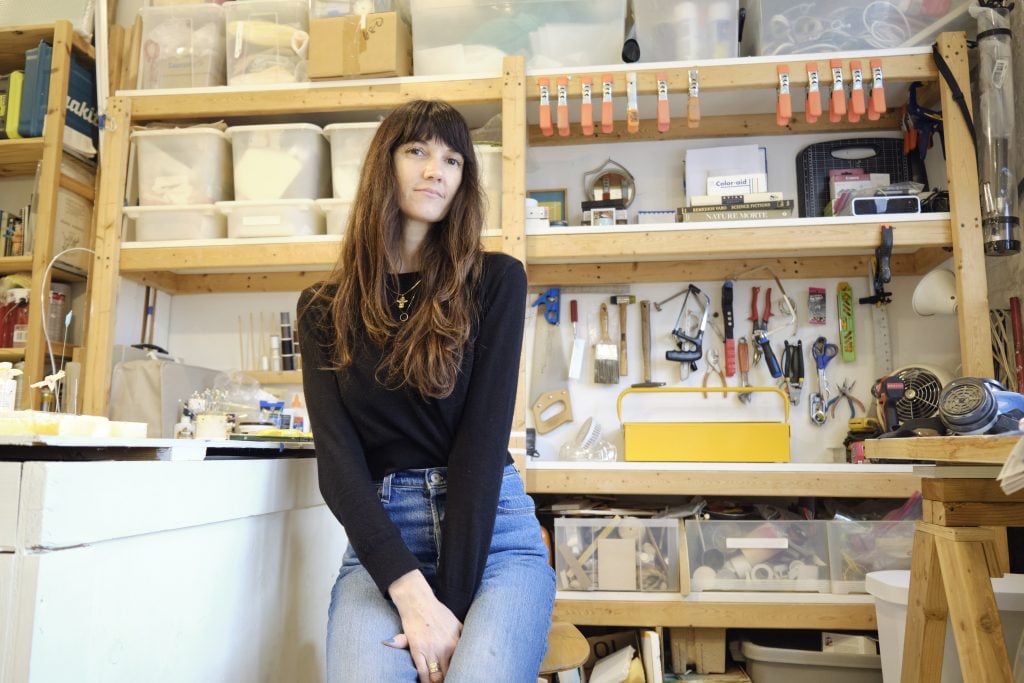
Brooklyn-based artist Langdon Graves transports viewers into a domestic fever dream in “Time is A Fire” the artist’s new solo exhibition at New York’s Dinner Gallery. Bringing together recent hand-built sculptures and Graves’s meticulous drawings, the exhibition transforms the mundane into the uncanny, while asking questions of time, mortality, familial legacy, artifice, and nature.
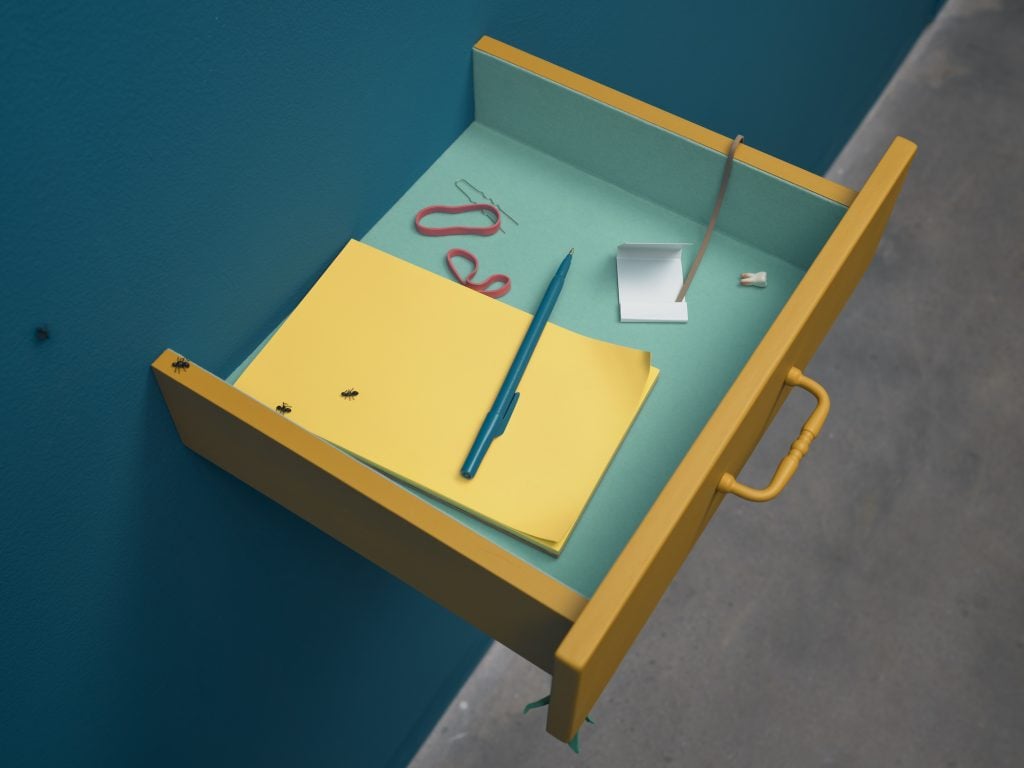
Langdon Graves, Keep Away From Children (2023-2024). Courtesy of the artist and Dinner Gallery. Photograph by Ethan Browning.
In one work, a kitchen drawer hangs open like a mouth. Amid its odds and ends a wisdom tooth lies extracted, its roots long, like an amulet. In another, a clothesline—the kind that once zigzagged city yards—juts out into the air, attached to nothing at all, while the other side is swallowed into the wall. A yellow bird tops a clothespin clipped to the line—the bird looks like it might be an old-fashioned decoration, but the ant crawling across the bird’s face suggests more morbid possibilities.
“Death has been at the center of my work for a long time,” Graves said in a conversation at her studio. “I’ve explored what we do to cope with it, question it, and doubt it. In many ways, my work has been about trying to cheat death. In this work, though, I am thinking more about time itself, the limited time we are given. Are there ways we can cheat time or stretch it?”
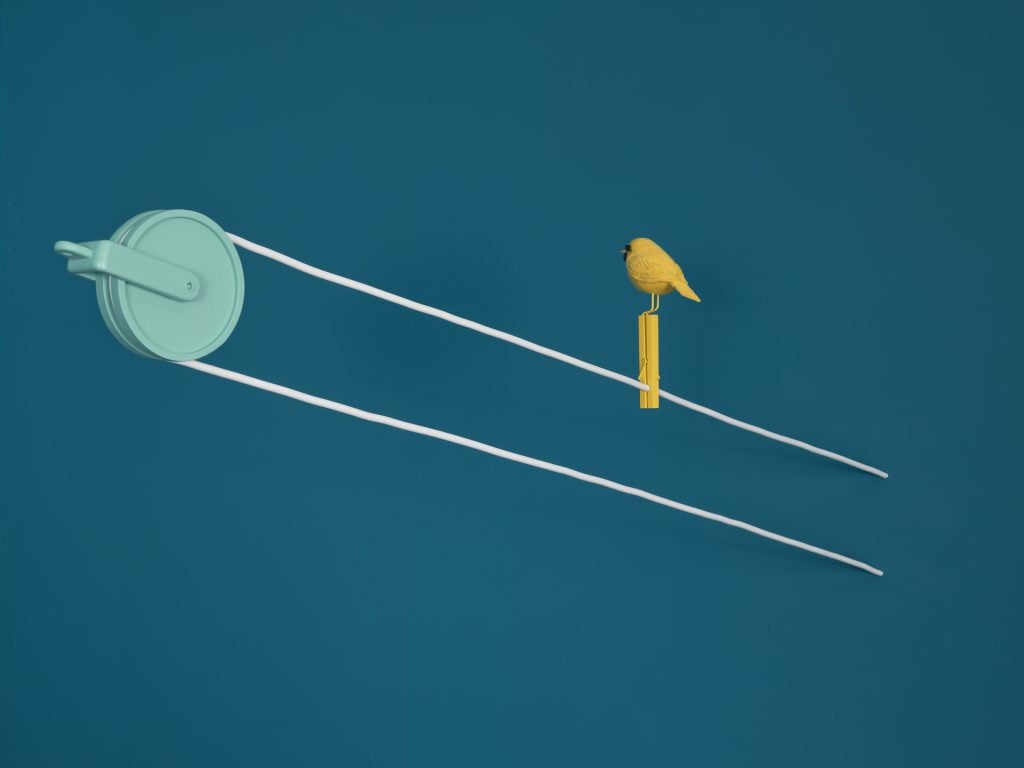
Langdon Graves, Soft Fascination (2023-2024). Courtesy of the artist and Dinner Gallery. Photograph by Ethan Browning.
The Virginia-born artist’s works have long explored a Southern folkloric and mythic world of ghosts, rituals, and communing with ancestors. In her 2019 exhibition “Months Mind” at Dinner Gallery (then named Victori + Mo) Graves explored her own family’s ghost stories—many told by her late grandmother—along with her research into spiritualist and mourning traditions. In “Time is A Fire” the works themselves have become increasingly intimate and personal, as the artist considers her relationship to life and death as a woman in her forties and the expectations placed on her.
“I’ve hit middle age, which inevitably has me thinking about time. As a woman, there are certain things it is assumed you’ll do—get married, have a baby. The art making is a way of processing some realizations, including the realization that I won’t have my own kids,” she said. “These aren’t subjects that weigh heavy in my heart, but more a way of trying to understand how life unfolds.”
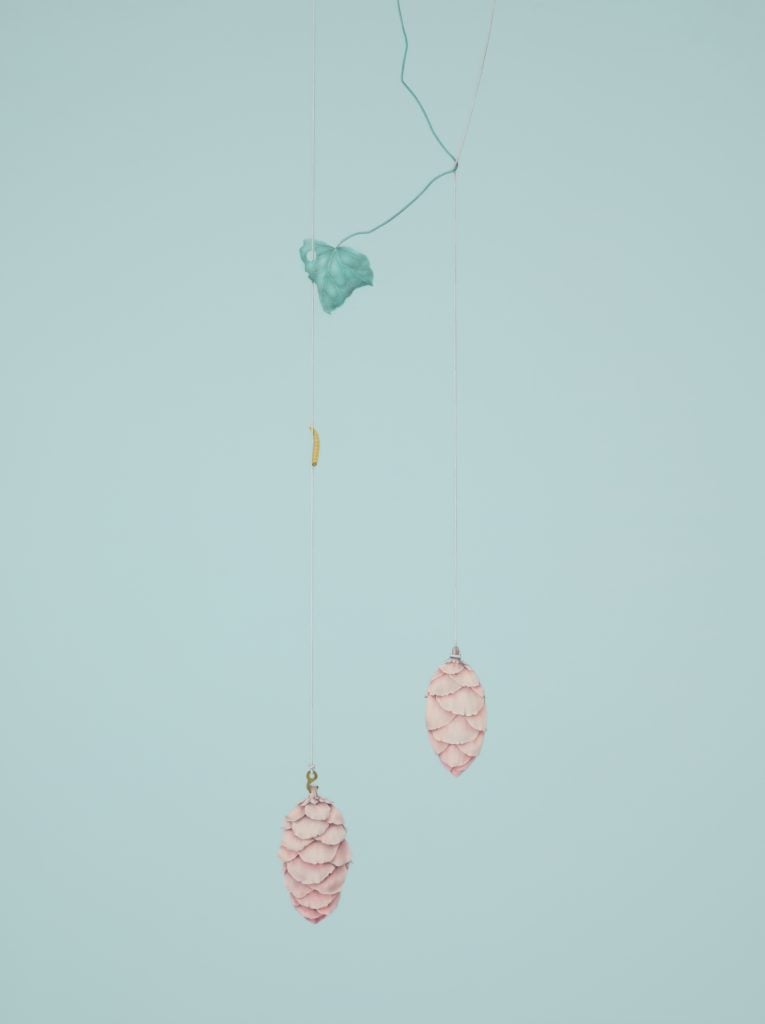
Langdon Graves, Endling (2023-2024). Courtesy of the artist and Dinner Gallery. Photograph by Ethan Browning.
Symbols of time and eternity recur throughout these works—birds, clocks, ivy vines. In the drawing Endling, (2024) two pinecones hang from strings, a pared-down reference to a cuckoo clock. The endling is the last surviving member of a species of animal or plant. Graves, who is an only child, wonders what shape a legacy takes on in the absence of future generations.
“My family has collected clocks from the Black Forest in Germany,” she said, “So I was thinking about making this drawing for a long time. At some point, it occurred to me that the cuckoo clock is the shape of a birdhouse. During the past few years, I’ve just spent hours staring out into my backyard in Brooklyn, watching our birdhouse and identifying different species of birds. Watching avian life in my yard is this beautiful sort of education that I’ve never really afforded myself, that is just observing, you know?”
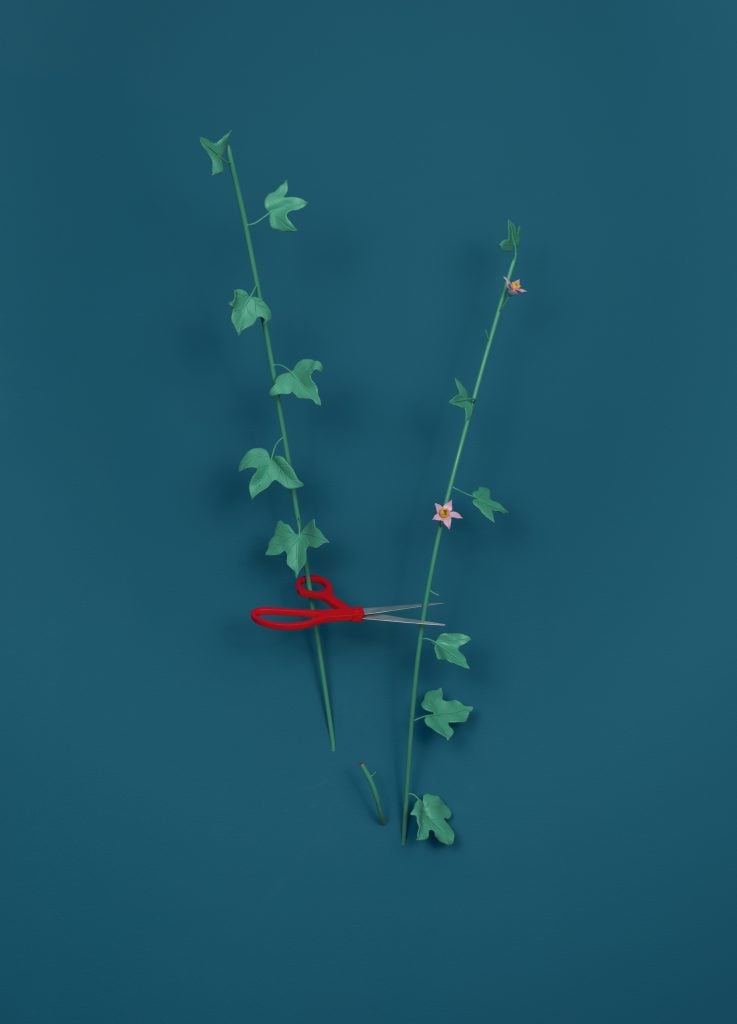
Langdon Graves, Flowers and Fragrance (2023-2024). Courtesy of the artist and Dinner Gallery. Photograph by Ethan Browning.
In the sculpture How did it get so late so soon? It’s night before it’s afternoon, a birdhouse perch takes the form of a human finger. At the tip of the finger, a clock’s hand pierces through the skin, alluding to the human desire to control time itself.
Levity unites these works in their desire for the impossible—the mischievous tricks we might play to attempt to outsmart time. In one work, the last match in a matchbook crawls, wormlike, away as though trying to escape its fate. This cunning manifests in Graves’s material choices as well—well-known for her drawings, Graves shifts her focus to her sculptural practice. Her colors have deepened too, suggesting a vespertine, somnolent world of deep greens and blues compared to the pale pastel hues that defined earlier exhibitions such as “Month’s Mind” in 2019 and “Spooky Action at a Distance” in 2016.
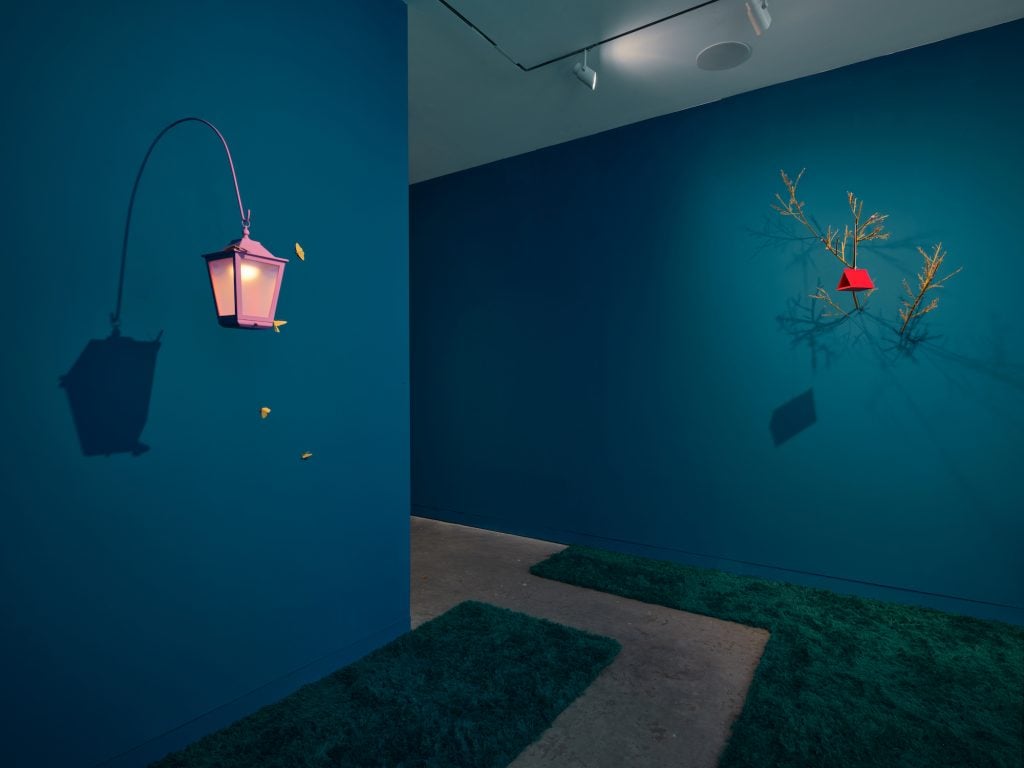
Installation view “Time is A Fire” 2024. Courtesy of the artist and Dinner Gallery. Photograph by Ethan Browning.
“More and more drawings my drawings are finding themselves as sculptures instead. There’s more emphasis on the physical relationship to the object, my relationship to the object,” she explained. “I need that interaction. The sculpture is a physical mirror for me.”
These sculptures take on trompe l’oeil attributes. Wood, brass, and modeling clay seem to become, in her sculptures, wrought iron, paper, flowers, and vines. Built by hand, the works are wonderfully deceptive, industrial and organic seeming at once, when, in truth, they are neither.
“I’ve been thinking about these works as large-scale miniatures. They’re made from materials that are model-making materials,” she said “Everything is so detailed, and while the scale is human-scale, they’re pretend. It’s almost like they’re for playing house.”
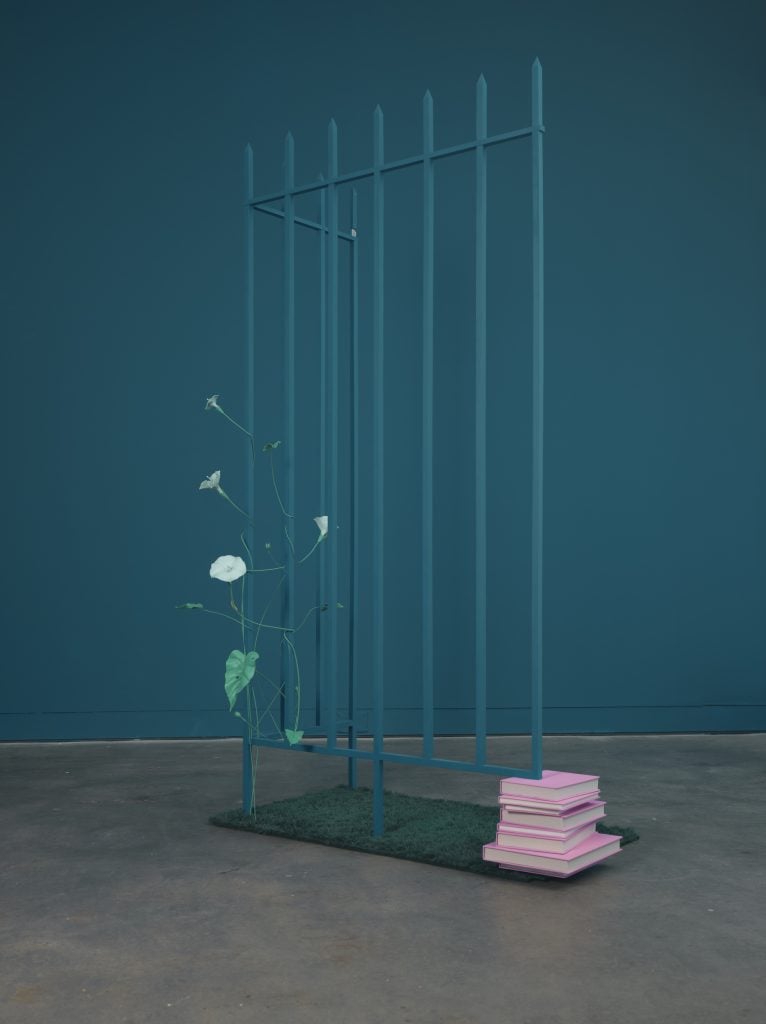
Langdon Graves, Bedmaker (2023-2024). Courtesy of the artist and Dinner Gallery. Photograph by Ethan Browning.
The sculptures hide small surprises, too. In Bedmaker, Graves used wood and polymer to create what looks like a wrought iron fence or gate. One side of the gate is supported by what looks like a stack of books—a reference to her home bedside table. The gate itself references the fencing of a cemetery the artist often visits in her Brooklyn neighborhood. “The work plays off of that phrase of ‘you’ve made your bed, now lie in it’ except here the bed is the death bed,” she said with a smile. But, the artist might also leave one more way out. On the top of one of the spikes of the gate, Graves has concealed a pocketknife—perhaps suggesting a final escape.
“I hope the humor comes through,” she said “Here, the inanimate objects are becoming a little bit more animated and the natural living things are becoming a little bit more plastic and preserved. Mostly I’m asking how we learn to live with all of the unknown.”





